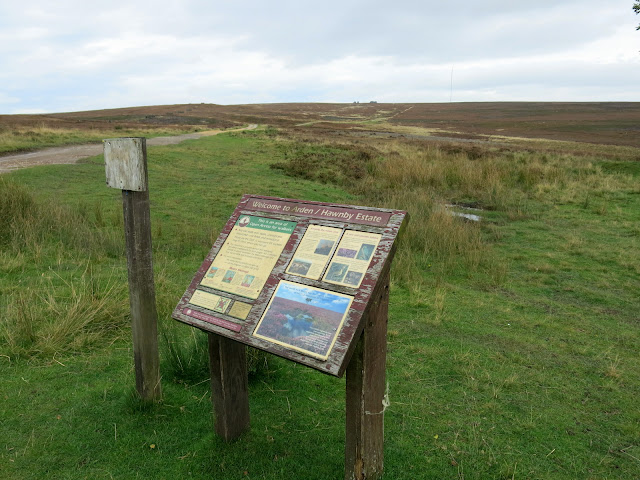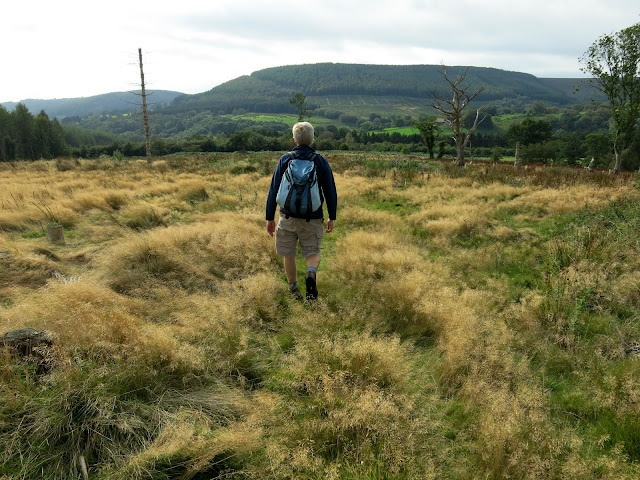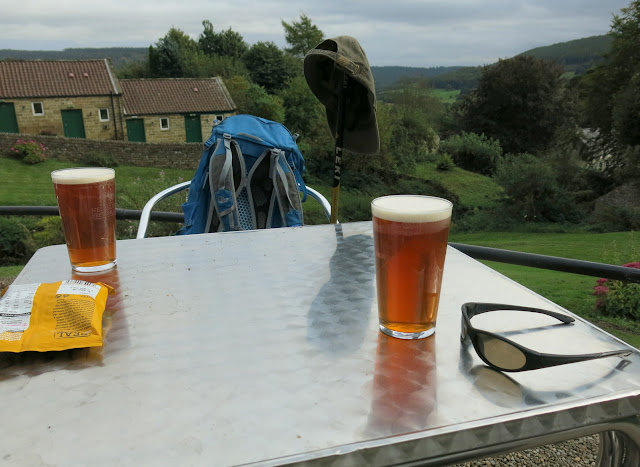Hawnby Hill and Hazel Head from Hawnby
7 miles Fair and warm
This is a favourite walk of ours as it combines the best of moorland, woods, pasture and villages. It's quite good underfoot, not too difficult but not too easy.
We arrived at Hawnby from the B1257
Stokesley to Helmsley road via the Laskill turn off and parked at the
roadside near the Inn at Hawnby.
 |
| Today's walk from The Walker's Guide to the Hambleton Hills |
 |
| Walking through Hawnby |
The village sits under Hawnby Hill
(298m) whose twin, Easterside Hill, can be seen over towards the B1257.
These two hills, known as Corallian Outliers, once formed
part of the Tabular Hills and have a very distinctive shape. We left
the road opposite the Inn and
immediately started to climb across a field, fighting through high
bracken that's now beginning to die back, until
we reached the top of Hawnby Hill. From here there is a good view in all
directions, to the left down to Arden Hall and to the right, Easterside
Hill.
 |
| Looking back towards Hawnby |
 |
| Bracken is past its best, thank goodness |
 |
| To the right is Easterside Hill |
 |
| To the left, Arden Hall |
We walked along the ridge of Hawnby Hill until we reached a large cairn, so regular that Clive and I suspect it to be the work of one person. Tom Scott Burns' photo of the cairn in the 1990's shows a small affair compared with today's. It is however, placed at the highest point of the ridge, 978 feet.
 |
| Cairn on Hawnby Hill |
A group of walkers were standing at the cairn and we stopped to pass the time of day, learning to our surprise that they were from Osmotherley, but had yet to do any walks from that village. We left them and continued along the ridge, at one point almost throwing ourselves flat as a pair of fighter planes buzzed us with a terrific roar.
 |
| "Whazzat??" |
 |
| There's another one... |
 |
| The end of the ridge, our path stretches out at 2 o'clock |
 |
| Down to the moor gate |
We passed through the Moor Gate and
walked along the sandy path of Sunley Slack and after about a mile came
to a fork in the road. We took the left fork and followed the path,
seemingly walking straight towards Bilsdale Mast. To our right was
Round Hill which is simply a collection of rocks and a bump in the
heather. Just by this we saw a wooden post with a yellow way mark
pointing left away from our track, across the moor towards Hazel Head
Woods whose tree tops could just be made out on the horizon. Although
the way mark pointed the way we must go there was no sign whatsoever of
any track, an experience which was to be repeated several times on this
walk. Obviously the area isn't being walked very much which is a real
shame as it has so much variety.
 |
| Sunley Slack |
 |
| Looking back at Hawnby Hill |
 |
| Male grouse with fine white gaiters |
 |
| Turn left just past this post... |
 |
| There should be a path here somewhere.. |
We followed a small path, almost hidden in the heather, until we came to a series of shooting butts, where we took up the more definite path which linked them together. In a while the trees of Hazel Head Wood could be seen to our left and we headed across to the wood via a series of sheep tracks. We walked alongside the wood, gradually dropping downhill until the ruined Wesleyan Chapel suddenly came into view.
We reached the chapel and used a couple of its fallen stones as seat and table while we enjoyed our coffee and scones.
 |
| We stride towards Hazel Head Wood |
 |
| The old ruined Wesleyan Chapel next to Hazel Head Wood |
 |
| Remains of ornate brickwork |
We retraced our steps and entered Hazel Head Wood, quickly coming to some ruined buildings. TSB says these once belonged to High Hazel Head Farm which was last inhabited in 1946, surprisingly recent considering the state of the ruins.
We followed a grassy track through the dark wood until, bearing left, we exited the wood above Hazel Head Car Park and the Osmotherley to Hawnby road.
 |
| Entering Hazel Head Wood |
 |
| A grassy track through the trees |
 |
| The ruins of Hazel Head Farm |
 |
| We emerge into the light... |
 |
| ... and cross to Hazel Head Car Park |
|
|
From the car park we followed the road left for a short time before turning into Ellers Wood at a footpath sign. This stretch seems unwalked and is made difficult by self-seeded saplings which obstruct what used to be the footpath.
Hidden in these saplings is a bridge that a stranger to the path might find difficult to locate, as we did the first time we walked here. We found the bridge and crossed the River Rye.
 |
| There should be a bridge in here.... |
 |
| There it is! |
 |
| The Bridge Over The River Rye |
We followed a grassy lane alongside Eskerdale Beck to a telegraph pole. TSB mentions a ruined building at this location and we did spot it but the telegraph pole is a better landmark these days.
At this pole turn left and follow the hill steeply up to reach and cross a stile in a hedge, then follow the path into conifers.
 |
| Alongside Eskerdale Beck |
 |
| Turn left uphill at a telegraph pole and aim for the next pole on the horizon |
 |
| St Agnes House Farm below us |
 |
| Rams chillin' in the sun |
These conifers were full of pheasants which we disturbed with our heavy tread. We followed our track alongside a
beck and then into the trees of Blueberry Wood. This whole area was wick with
young pheasants which ran along the path in front of us. There were
feeders every few yards. Eventually we emerged from the conifers above St Agnes Head Farm and to a surprise view.
 |
| Pheasants take to the air as we approach |
Passing St Agnes House farm we dropped
down to a nice ford where we crossed a footbridge into Low Wood. Soon
we came to the attractive arched bridge over the Rye, not mentioned by
TSB as it post dates his book, being built to replace a bridge washed away by flooding in 2005.
We were astonished to find that much of the wood that makes Half Moon Plantation has been felled in the last year, leaving the arched bridge totally exposed downstream.
 |
| We spot the arched bridge over the River Rye |
 |
| .... and then come across a scene of devastation! |
 |
| Looking downstream from the bridge |
 |
| A different view looking upstream! |
From the bridge we had a short scramble up to a track leading right, coming out of the woods at the lonely Carr House. From here we followed way marks (but no path) through
several fields until we rejoined the Hawby road where we walked into the
village and into the Inn at Hawnby.
 |
| A scramble uphill.. |
 |
| We pass above Hawnby Lodge... |
 |
| ... and reach The Inn at Hawnby |
 |
| The Hiker's Reward |
